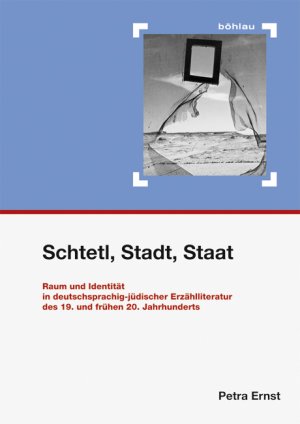
At first glance, the study of the formation and development of German Jewish literature is a matter that has been thoroughly debated, especially in German, as well as in cultural and literary studies of the past decades. One might assume that all possible interpretations have been exhausted by the numerous well-established or smaller publications, whose achievements vary greatly thematically, critically and in their methodological approach.1 The book by the German and cultural studies scholar, Petra Ernst, was published at Graz University in the series Schriften des Centrums für Jüdische Studien (vol. 27), to whose foundation and development she actively contributed until her untimely death in 2016. Her research is part of the monumental effort to examine the formation and evolution of German Jewish literature; clearly distinct from the earlier superficial writing on the subject, it is distinguished by the critical and reflexive approach afforded by its descriptive analysis and synthesis. Ernst opts for a complex, interdisciplinary methodology and displays remarkable interpretive proficiency, as well as very good knowledge of primary and secondary literature in philology, history and literary criticism, not to mention cultural and Jewish studies. Ernst’s work reflects the recent trend of studying literary works by resorting to theories from related areas in order to gain a new understanding of the subject matter.2
The study investigates prose texts by Jewish writers who published in German throughout the 19th century and at the beginning of the 20th, such as Leo Herzberg-Fränkel, Nathan Samuely, Karl Emil Franzos, Leopold Kompert, Selig Schachnowitz, Eduard Kulke, Max Grünfeld, Salomon Hermann Mosenthal, Salomon Kohn, Fritz Mauthner, Georg Hermann, Hugo Bettauer, Leopold Hichler, Theodor Herzl, Ernst Sommer, Sammy Gronemann, Karl Teller and others. The three main conceptual elements at the basis of her analysis are space, place and identity, correlated with the situation of the Jewish diaspora in the German, Austro-Hungarian and Russian Empires, as well as with historical events of the time. Petra Ernst makes productive and original use of theories from cultural studies, especially those of Georg Simmel, Henri Lefebvre, Michel de Certeau and Michel Foucault. The book is comprised of four main chapters followed by three final chapters which contain a synopsis of the work, a bibliography and an index.
The first chapter focuses on the theory and methodology informing the study as a whole, thus achieving remarkable coherence and enabling the reader to perceive the red thread of the text. One of the book’s achievements is the perspective on the concept of German Jewish literature, which in Ernst’s belief is a phenomenon so complex that a profound understanding of it can only be gained by making use of interpretive models borrowed from the theory of systems. Consequently, German Jewish literature is seen as part of a broader, autonomous system, which in turn reflects the identity mobility of the community shaped by numerous internal and external factors in its interaction with several historical and cultural contexts. In the first part of the work, the explanation of the key terms (Jewish) space, place and identity, deeply joined to the narrative act, bears testimony to the author’s praiseworthy understanding of current developments in the research of the subject matter and her ability to make use of the theoretical approaches that best serve the analysis. The starting point is the realization that, in the 19th century, space is a central category of numerous German Jewish literary texts. Space is in close connection to the political, economic, social, religious and cultural changes that swept a great number of diverse geographical places. Petra Ernst identifies topoi such as the shtetl, the city or the state, which in turn determine the formation of specific types of text such as the “Ghettogeschichte” (stories which focus on the life of the shtetl or ghetto), the “Großstadtroman” (the city novel) or the Zionist novel. These macro spaces are, on the one hand, references to existing geographical places with concrete components such as the synagogue, cheder, cemetery and tavern in the case of “Ghettogeschichte” or streets, boulevards, neighborhoods, hotels, cafés, restaurants and theatres in the case of the “Großstadtroman.” On the other hand, one must not forget that these spaces must not be understood as fixed, changeless structures, but as spaces going through perpetual transformation - themselves under the influence of phenomena such as industrialization, urbanization and migration – and as such their significance is dynamic and contextual. The next three chapters concentrate on the three above named types of narration. A few of the considered questions are: the way in which spaces and places are constructed in a narrative sense, the presence and significance of some motifs and topoi, and the role played by Jewish literature written in German in the context of the significant social transformations between 1840 and 1920.
Petra Ernst’s book represents a judicious contribution, based on thorough arguments and detailed documentation, that follows the origin, evolution and functioning mechanisms of German Jewish literature from the beginning of the 19th until the first decades of the 20th century. Some of the analyzed texts are truly outstanding, taken from works by unjustly forgotten or not widely known authors such as Nathan Samuely, Michael Klapp, Salomon Kohn, Max Grünfeld, Georg Hermann, Ernst Sommer, Karl Teller.
Although the work would primarily be of interest to specialists in the fields of Jewish or cultural studies and German literature and history, due to its thesis, methodology and selected texts, it can also be a stimulating read for those interested in the history of the Jewish communities of Central and Eastern Europe as it offers a productive mode of interpretation and reflection.
Francisca Solomon, Alexandru Ioan Cuza University of Iași
Petra Ernst, Schtetl, Stadt, Staat. Raum und Identität in deutschsprachig-jüdischer Erzählliteratur des 19. und frühen 20. Jahrhunderts, (Wien-Köln-Weimar, Böhlau Verlag Wien, 2017), pp. 474.
DOI: 10.48248/issn.2037-741X/1316